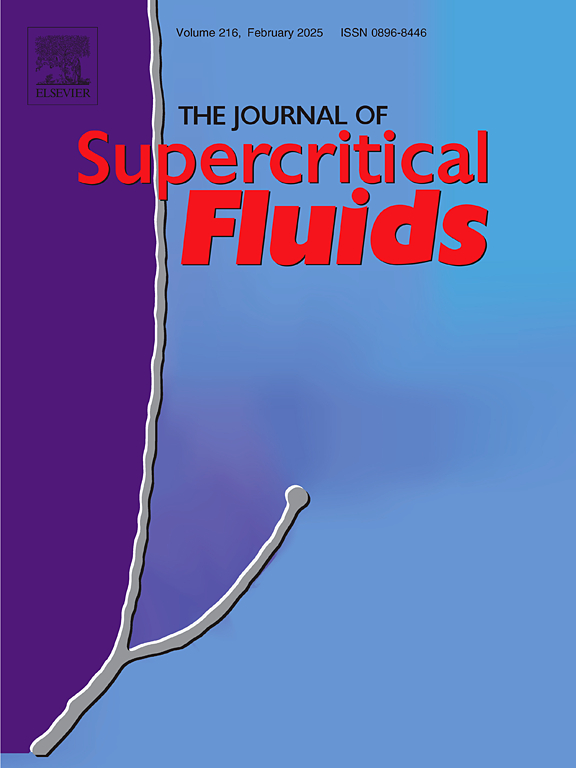Valorization of cocoa bean shell residue from supercritical fluid extraction through hydrothermal carbonization for porous material production
IF 3.4
3区 工程技术
Q2 CHEMISTRY, PHYSICAL
引用次数: 0
Abstract
This study investigated the potential for high-value utilization of cocoa shell (CS) residues derived from supercritical fluid extraction (SFE) by converting them into hydrochar through hydrothermal carbonization (HTC) and activation (A-HTC). Hydrochar produced from residues extracted with water as a co-solvent exhibited the highest carbon content (78.7 %) after HTC and activation, highlighting the critical role of the co-solvent in optimizing dehydrogenation and dehydration reactions. Structural analysis revealed that residues rich in water-soluble components formed smaller pores, whereas lipid-rich residues formed larger pores. Activated hydrochar obtained from water-extracted residues demonstrated the largest surface area (315 m²/g) and pore diameter (7.10 nm), indicating mesoporous properties suitable for adsorption applications. The Van Krevelen diagram confirmed that HTC hydrochar stability improved through condensation and aromatization processes. By integrating SFE with HTC, this study presents a systematic approach for converting by-products into high-value hydrochar, offering a sustainable solution for resource recycling and utilization.
超临界流体萃取可可豆壳渣水热炭化制备多孔材料的研究
本研究探讨了超临界流体萃取(SFE)可可壳(CS)残留物通过水热碳化(HTC)和活化(A-HTC)转化为碳氢化合物的高价值利用潜力。以水为助溶剂提取的残渣经HTC和活化后生成的氢炭碳含量最高(78.7% %),突出了助溶剂在优化脱氢和脱水反应中的关键作用。结构分析表明,富含水溶性组分的残基形成较小的孔隙,而富含脂质的残基形成较大的孔隙。从水提残留物中获得的活化氢炭具有最大的表面积(315 m²/g)和孔径(7.10 nm),表明适合吸附应用的介孔性质。Van Krevelen图证实,通过缩合和芳构化过程,HTC烃类的稳定性得到了改善。本研究通过将SFE与HTC相结合,提出了一种将副产物转化为高价值烃类的系统方法,为资源回收利用提供了可持续的解决方案。
本文章由计算机程序翻译,如有差异,请以英文原文为准。
求助全文
约1分钟内获得全文
求助全文
来源期刊

Journal of Supercritical Fluids
工程技术-工程:化工
CiteScore
7.60
自引率
10.30%
发文量
236
审稿时长
56 days
期刊介绍:
The Journal of Supercritical Fluids is an international journal devoted to the fundamental and applied aspects of supercritical fluids and processes. Its aim is to provide a focused platform for academic and industrial researchers to report their findings and to have ready access to the advances in this rapidly growing field. Its coverage is multidisciplinary and includes both basic and applied topics.
Thermodynamics and phase equilibria, reaction kinetics and rate processes, thermal and transport properties, and all topics related to processing such as separations (extraction, fractionation, purification, chromatography) nucleation and impregnation are within the scope. Accounts of specific engineering applications such as those encountered in food, fuel, natural products, minerals, pharmaceuticals and polymer industries are included. Topics related to high pressure equipment design, analytical techniques, sensors, and process control methodologies are also within the scope of the journal.
 求助内容:
求助内容: 应助结果提醒方式:
应助结果提醒方式:


